Fortress Europe has gone live on Forces, so now you can get to putting together a Late War list for your Launch Weekend battles!
Get cracking on your German, Soviet, British, or American Late War lists here…
Join the Battlefront team as we launch Bagration: Soviet
Fortress Europe has gone live on Forces, so now you can get to putting together a Late War list for your Launch Weekend battles!
Get cracking on your German, Soviet, British, or American Late War lists here…
with Phil Yates
Through 1943, the Soviet Union has gone from victory to victory, throwing the Germans back almost to the borders of Russia in a non-stop series offensives, never giving them time to recover before the next blow falls. These successes have bought time for the Red Army to sharpen their tactics, and despite high casualties, keep formations intact long enough to retain these new skills.
The unrelenting pace of these offensives has led to a dichotomy between formations freshly rebuilt with new conscripts ready for the next offensive, and the heroic survivors that remain after each bloody battle, pushing on as they have time after time. So desperate is the need for troops that even obsolete equipment like the M3 Lee and the KV-1 are still found fighting on the flanks of the latest equipment like the T-34/85 that form the spearheads. The question is simply which of the many options will you field?
T-34 Tank Battalion
Hero T-34 Tank Battalion
KV-1s Guards Heavy Tank Regiment
Churchill Guards Heavy Tank Regiment
M3 Lee Tank Battalion
Rifle Battalion

Hero Rifle Battalion
Motor Rifle Battalion
Hero Motor Rifle Battalion
Reconnaissance Company
Support

How Do the Soviets Play?
The victories won by the Soviet Union in 1943 — Stalingrad, Kursk, Donbass, Dneiper, Smolensk, and Kiev amongst them — showed the increasing skill and power of the Red Army and threw the Germans onto the strategic defensive. As 1944 begins these hammer blows continue without respite.
A Wide Variety of Styles
However, by 1944, the Red Army was running out of people to replace casualties, so they created several tiers of formations. At the bottom of the pile were the rifle divisions who were usually desperately short of riflemen. To solve this problem, they’d conscript any adult males from the areas they liberated straight into the ranks. The result was renewed strength, but very limited skill, so they are rated Confident, Green, and Aggressive with a save of just 4+. These massive formations were quickly attrited down to the same old band of heroes who had fought their way back westward since Stalingrad. These heroes are rated Confident, Veteran, and Aggressive, reflecting their crafty tactics and brutal hand-to-hand combat skills, while retaining their aggressive tactics that put defeating the Germans above personal survival.
The tank battalions follow a similar pattern, with the tough heroes of a dozen battles rated as Confident, Trained, and Aggressive with their ‘Crafty’ tricks reflected in a better Tactics rating. When rebuilt with conscripts fresh from training, of necessity their tactics become simpler and their skill rating drops to Green, although their determination to take ‘Not One Step Back’ gives them a better Last Stand rating.
The motor rifle brigades that supported the tanks were given priority for the available manpower as they were seen to be the key to ultimate victory. With almost as many officers and NCOs as soldiers, even freshly-raised units fought with skill, so are rated as Confident, Trained, and Aggressive, although still have the speed and lowered save associated with massed tactics. Once they get battle-hardened, the heroic survivors are rated as Veteran. Like most Soviet infantry, their aggressiveness and high proportion of automatic weapons give them an improved Assault rating as they fight ‘For the Motherland’.
The Sledgehammer or the Rapier?
As you can see, there are two distinct sides to the Red Army, the units brought back up to strength or the next offensive with raw recruits doomed to a very bloody and usually very brief introduction to combat, and the battle-hardened survivors, the heroes of many battles who had seen recruits come and go many times.
These two play very differently on the table. The huge units of new recruits are a sledgehammer, swung with maximum force at the key point in the enemy line, smashing through with devastating speed and crushing strength. They will take huge casualties, so you need to be bloody minded and focus on victory above all else. You must win quickly while you have the strength to shatter your foe, or watch your forces bleed away to nothing.
The heroes of many battles still need to fight aggressively, as their strength will also bleed away quickly, but they need to use finesse rather than massed numbers. They must use their superior speed and skill to gain local superiority in numbers, firepower, and position, then cut the enemy apart.
No matter what their level of skill, Soviet troops have lots of firepower, often from larger calibre guns than their opponents, and are deadly up close. The key to victory is using speed and aggression to overwhelm a section of the opponent’s force at close range, before exploiting their success to win victory.
What to Expect in Bagration
As you’d expect, when the Bagration book arrives, it will expand on the forces in Fortress Europe with bring new equipment like the powerful IS-2 heavy tank with its 122mm gun, thick armour, and the speed of a medium tank, the ISU self-propelled versions mounting guns as big as 152mm, and the deadly SU-100 tank killer that can easily make short work of a German Tiger or Panther! The book will introduce new formations such as specialist assault troops, ideal for breaking through German defences and clearing out fortified towns and cities.
However, we won’t get to Operation Bagration and the Eastern Front for a while, so to keep Soviet players going until then, the Soviet component of Fortress Europe is pretty beefy (easily the biggest in the whole book). It’s got lots of stuff to help you build the core of your collection and start playing.
Join Victor as he unboxes the American Starter Force:
To help you get your models in tip top shape for the table, we teamed up with Pete the Wargamer to bring you some easy to follow tutorials using all the good info from Colours of War…
with Phil Yates
The US Army focused on standardisation to enable it to fight a war on a far-away continent. At the beginning of 1944, they had one type of medium tank, one type of light tank, one armoured infantry organisation and one infantry organisation.
This makes it easy if you are planning to field an American force. Your most important decision is how to combine these standardised components to win your battles. Do you want to go tank-heavy, with just a little infantry support? Do you want to field a solid infantry force with a few tanks for backup? Or do you want to field a balanced mix with the right tool for every situation?
M4 Sherman Tank Company
M5 Stuart Tank Company
Armoured Rifle Company
Rifle Company
M10 Tank Destroyer Company

Support
How Do the Americans Play?
The American forces in this book represent the fresh divisions pouring into Europe ready for the D-Day landings. They are well trained and eager for battle, although still lacking in actual combat experience to polish off the rough edges and teach them the difference between training and life-or-death battle. Most are rated as Confident, Trained, and Aggressive. Their eagerness shows in their ‘Blood and Guts’ approach to warfare which gives their tanks a better Last Stand rating and their infantry a better Rally rating.
American tanks have stabilisers, so they can fire as quickly on the move as at the halt (although not as accurately). On the other hand, they are not heavily armoured and mount mid-range guns, so need to use weight of numbers and clever manoeuvring rather than frontal firefights to defeat enemy tanks.
Their infantry have Garand semi-automatic rifles and BAR automatic rifles, as well as half-track-mounted weapons, and can fire just as well on the move as they can when halted. They are fast moving and have plenty of fire support. Let their support pound the enemy while the manoeuvre, then swamp the enemy in fire and roll over them from an unexpected direction.
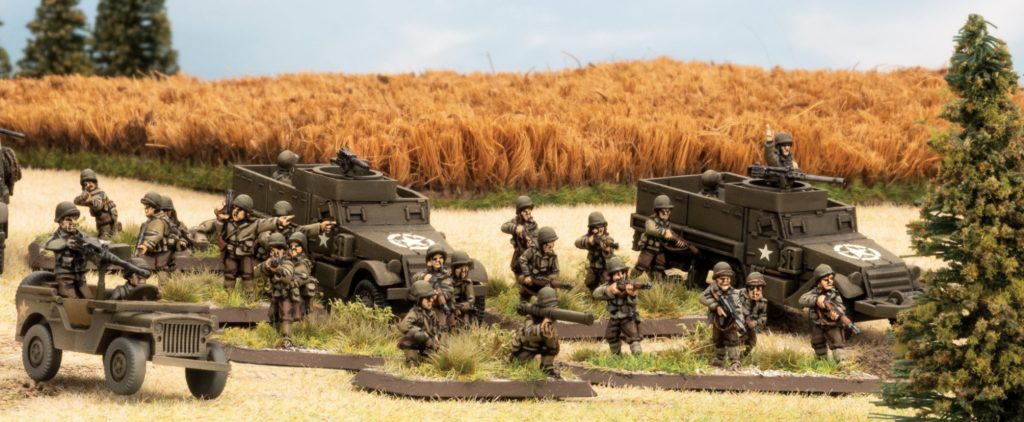
What to Expect in D-Day: American
Your Fortress Europe force will easily transfer to D-Day: American, gaining some useful new kit and skills in the process. Your tankers will appreciate upgunned M4 Shermans mounting 76mm and 105mm guns, and your infantry will find the new 57mm anti-tank gun an improvement over their old 37mm gun.
Some of your older equipment like the M3A1 armoured car and T30 self-propelled guns will be phased out, to be replaced with improved M8 armoured cars, M20 scout cars, and M8 Scott self-propelled guns.
D-Day Americans will also bring veteran American formations. These troops have been through the school of hard knocks. They’ve learned the hard way, so they aren’t as gung ho any more, but their tactics are much better.
There will be lots of totally new options for a whole new D-Day force as well.
As you’d expect these improvements come at a cost, and some players will elect to stick with what they have in Fortress Europe, preferring extra numbers over increased performance. Whichever way you go, your Fortress Europe force is a solid base for any future developments.
with Aaron Te Hira Mathie
Not being a big World War 2 ‘guy’ I don’t have an army to expand upon.
However, I have set myself a little challenge for the launch day.
I’m going to try and complete a platoon of British Sherman tanks
Over the course of the day we shall see how far I get.
Join Wayne as he unboxes the German Starter Force:
with Phil Yates
Despite the setbacks of 1943, at the start of 1944 the German Army was still a formidable force. The front-line forces were receiving increasing numbers of the latest weapons, including Tiger and Panther tanks, powerful 8.8cm tank-hunters, and armoured infantry half-tracks, and the soldiers manning them were highly-skilled, hard-bitten veterans, still confident of victory despite the many enemies arrayed against them.
Perhaps the biggest challenge of building a German force is simply choosing what to take. There are so many exciting options, but their exceptional quality — both technically and in their training and doctrine — limit what you can take. The good news, though, is that this makes it easy to collect a variety of options and vary your force depending on the situation you expect to face and the style of tactics you want to try out today.
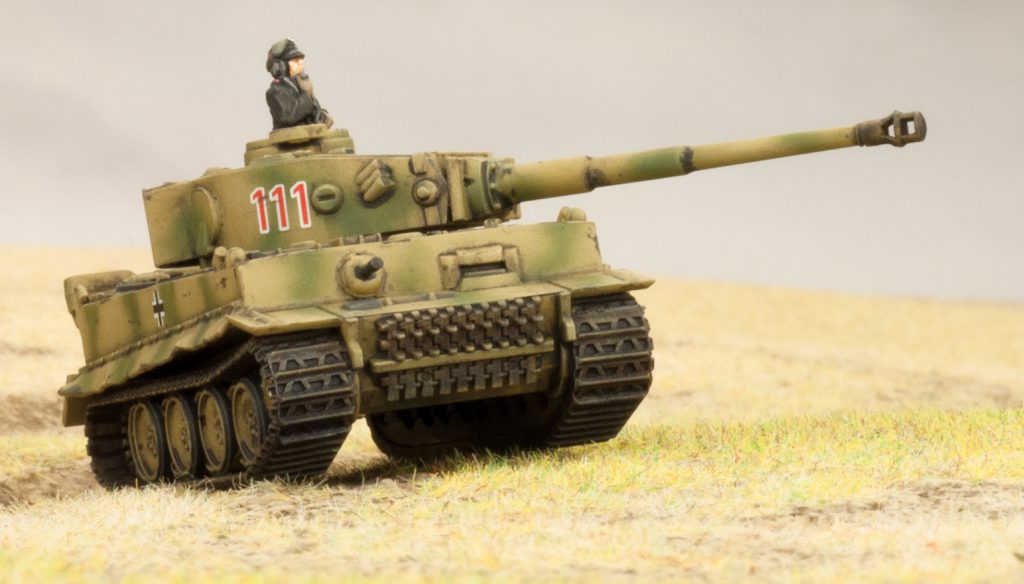
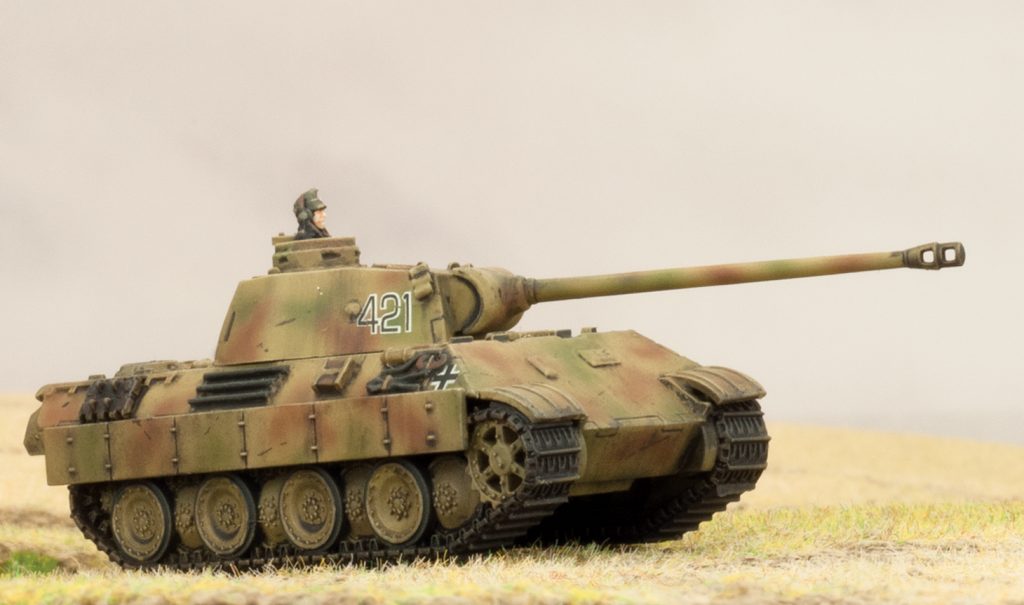
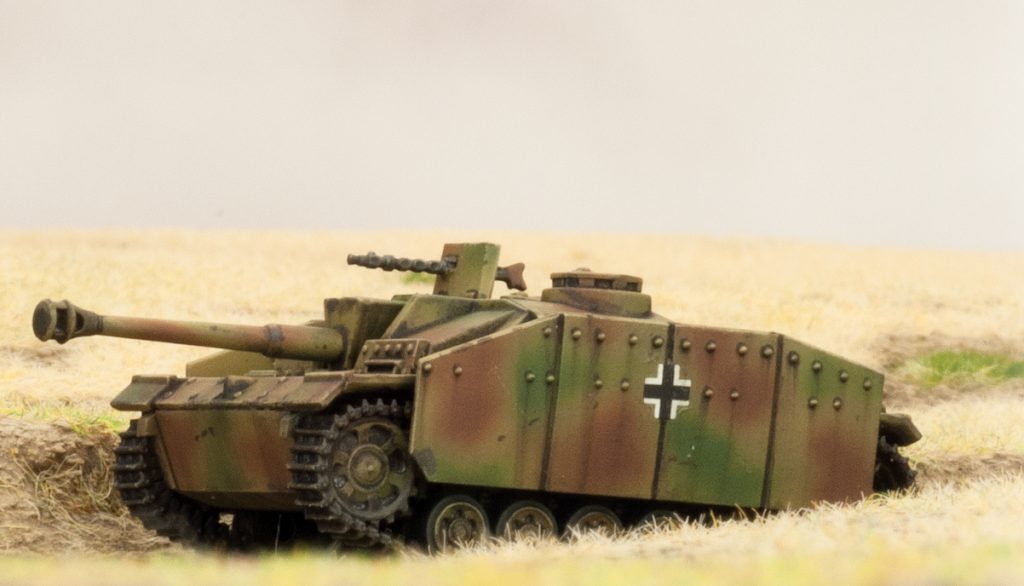
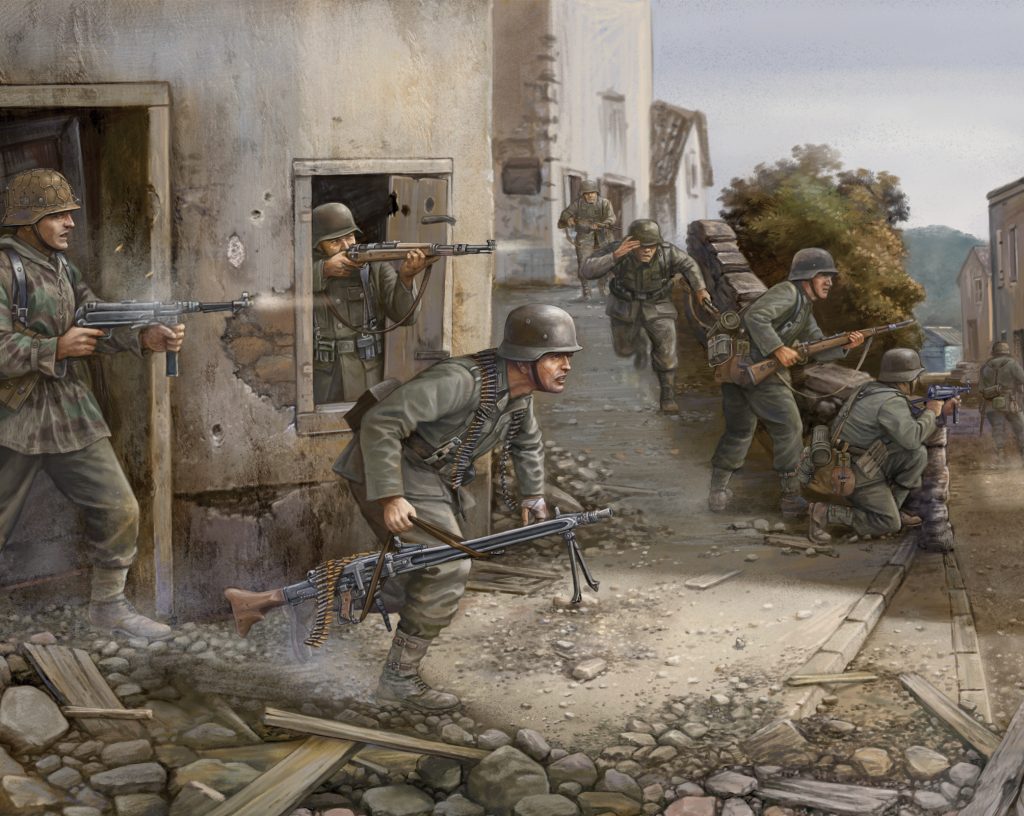 Grenadier Company
Grenadier CompanySupport
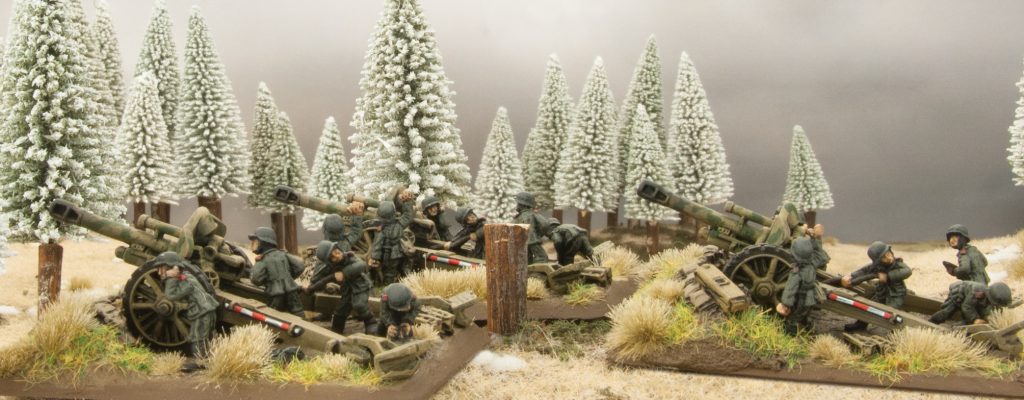
How Do the Germans Play?
The Germans in Fortress Europe are among the last of the old guard, trained before the tide turned, in the days when Germany was winning the war. They are rated as Confident, Veteran, and Careful, so are some of the best trained and most experienced troops available. Their faith in the thousand-year ‘Third Reich’ gives them a better Last Stand rating, so you can trust them to hang in there, even when things look bad.
This training follows in the footsteps of their legendary forebears, the stormtroopers of the First World War. Their Stormtroopers ability allows German troops to attempt two movement orders in each turn. Combined with their high skill rating, this allows them to fight with a finesse that no other army can match.
To go with this superb level of tactical prowess, German engineering provides you with the best tanks, such as the Panther and Tiger, and the most powerful guns, like the long 8.8cm which can penetrate any tank with ease. Even older tanks like the Panzer III have been brought up to the latest standards with bazooka skirts and HEAT ammunition.
In summary, a successful German force will use their superiority in equipment, training, skill, and cleverness, combined with a good dose of aggression, to keep the initiative, hit the enemy in their weak spots, while minimising the enemy’s opportunities to hit them back.
What to Expect in D-Day: German
Your Fortress Europe force will easily transfer to D-Day: German, transforming into a classic late-war force in the process.
Because the panzer divisions in Normandy had just been rebuilt with new equipment, all of their old equipment like Panzer III tanks and Ferdinand tank-hunters have been phased out, and replaced with useful new tools. In recognition of the increasing Allied airpower, the tanks gain their own integrated anti-aircraft, including powerful Mobelwagen self-propelled AA mounted on the Panzer IV chassis. The StuG assault guns have their own infantry escorts, and the infantry start fielding the very effective 12cm heavy mortar.
At the opposite end of the spectrum, the infantry charged with defending the ‘Atlantic Wall’ are mostly older family men and foreign conscripts, so the quality and resilience of your grenadiers is much reduced. On the other hand, you will get cheap infantry to hold ground while your elite panzer divisions fight a mobile battle.
D-Day: German will bring plenty of other exciting new choices and forces as well.
If these improvements aren’t for you, or you want to keep fighting on the Eastern Front, you might prefer to stick with Fortress Europe, and you certainly won’t be disadvantaged by doing so. No matter which way you plan to go, a Fortress Europe force is a good solid way to begin your journey.
What About D-Day: Waffen-SS?
The D-Day: Waffen-SS book is a little further away, so if that is your destination, you’ll want either Fortress Europe or D-Day: German (or both of them) to start building a panzer or panzergrenadier force in the meantime, ready to join the Waffen-SS when they arrive.
with Phil Yates
Fortress Europe is the first step on the journey from the battlefields of Normandy to the ragnarok of Berlin. It is the first Late War book written specifically for the latest version of Flames Of War.
This book has three targets:
For a Beginner Starting their Journey
Fortress Europe is a great sampler for a beginner just starting out as it covers the big four of Late War: Americans, Germans. British, and Soviets. This gives you the chance to see the types of equipment, the levels of training, and the play style of each army before deciding which to collect. It also has the added bonus of giving you valuable insights into the opposition you’ll face on the table top!
For a Mid War Player Transitioning
If you already have a Mid War army, you can probably use a lot of it as the basis of a Late War army. Fortress Europe includes all of the Mid War troops and equipment that can make this transition. The big difference between your Mid War army and its Late War incarnation will be the points.
While infantry are pretty much the same points in both periods, tanks get a lot cheaper, so the American M4 Sherman tank goes from 8 points each as a pretty powerful Mid War tank, to less than 4 points each as a baseline Late War tank, even with better skill! The Tiger changes even more, dropping from a hefty 29 points as the super tank of Mid War, to just 12 points as a powerful, but certainly not unbeatable, Late War tank.
At the top end though, the super tough Ferdinand tank-hunter still has exceptional armour and an exceptional gun, so its points only went down from 17 points to 13 points. At the bottom end, a patrol of three Luchs scout tanks went from 6 points to 5 points, since its function as a lightly-armed and lightly-armoured reconnaissance vehicle hasn’t really changed.
These changes make the same army play quite differently. Your M4 Sherman tank company goes from being a handful of powerful tanks to a horde, your Panther tank company moves from the realm of super tanks to become a good medium tank, and so forth. There’s a lot to learn about how to handle your force in this brave new world and a lot of fun to be had doing so.

For British and Eastern Front Players
Late War will be a journey from the beaches of Normandy to the end of the war at Berlin. It will be an exciting adventure, but like anything worthwhile, it will take time to reach our destination. So, much as we’d love to be able to give every nation and theatre exciting new books right now, someone has to wait. Meanwhile, Fortress Europe gives British, Soviet, and Eastern Front German players the opportunity to start collecting their army and get some games in while they are waiting.
What’s In The Book?
Fortress Europe starts with a brief history of the second half of World War Two before diving into the big four of late war: Americans, Germans. British, and Soviets. Each of these has an introduction giving you an idea of their approach to this war, a guide to their most important tanks, their force diagram, their special rules, and then an extensive list of various formations that they can field. The book ends with a comprehensive two-page basing guide telling you how all of the different infantry teams and guns are based, and a catalog of the exciting new Late War products arriving in stores near you.
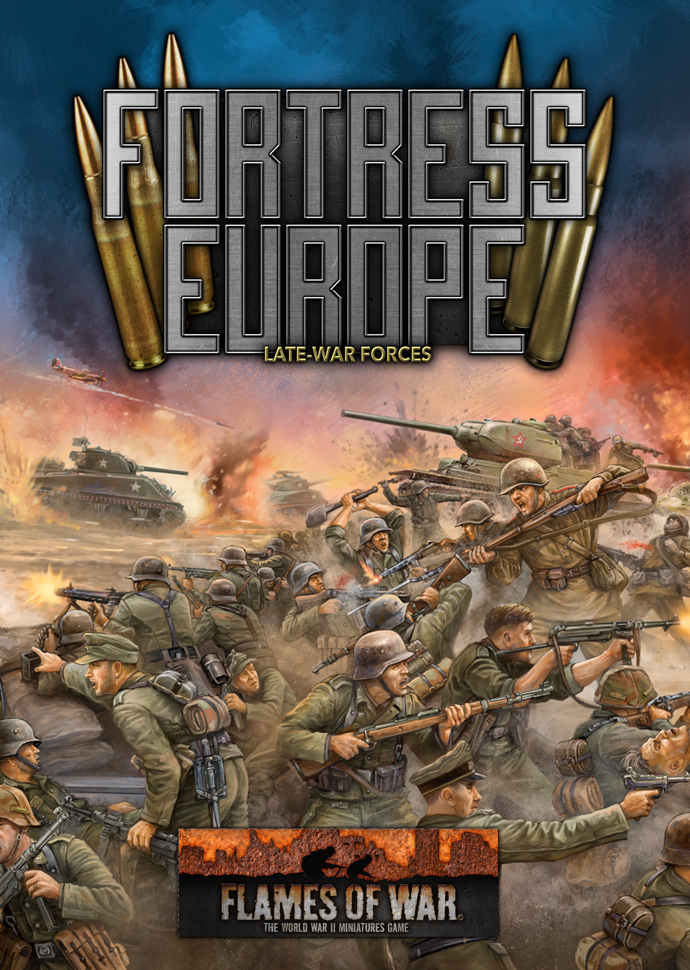
You can find out more about the Flames Of War Digital App here…